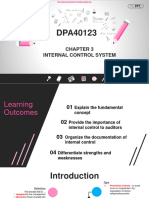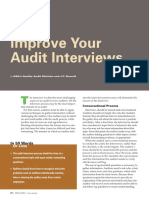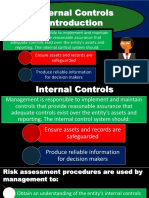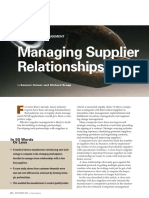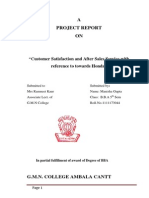Control Financiero y Calidad
Control Financiero y Calidad
Uploaded by
Ramón G. PachecoCopyright:
Available Formats
Control Financiero y Calidad
Control Financiero y Calidad
Uploaded by
Ramón G. PachecoOriginal Description:
Copyright
Available Formats
Share this document
Did you find this document useful?
Is this content inappropriate?
Copyright:
Available Formats
Control Financiero y Calidad
Control Financiero y Calidad
Uploaded by
Ramón G. PachecoCopyright:
Available Formats
ECONOMIC CASE FOR QUALITY
Financial Control
And Quality
by William Stimson and Tom Dlugopolski
ver the years there have been many qual-
O ity strategies, but Six Sigma has gotten
the most attention from top manage-
ment. ASQ has examined the Six Sigma phenome-
non and understands that Six Sigma’s success is
based on its attention to the corporate bottom line.
As a result, ASQ has undertaken a major program,
“The Economic Case for Quality.”1
The case should be easy to make. Quality brings
a distinct financial advantage to those who practice
it diligently as opposed to those who don’t.2
However, we believe the case for quality is not at
all obvious to the top floor. Regardless, top man- agement must be aware of and control its corpora-
tion’s finances to comply with the Sarbanes-Oxley
Act (SOX).
There are two aspects to measuring financial
In 50 Words control: materiality and liability. When quality is
Or Less expressed in these terms, its value should be clear
to executive management. The goal of this article is
to measure the cost of quality in materiality and
• There are two aspects in measuring financial control:
liability because they are critical financial measures
materiality and liability. for any company.
• Every CEO can understand the financial measures of Rationale for Financial Metrics
In the era of mass production, many companies
quality in terms of the strategic goals of the company.
can no longer ensure the quality of their products.
In-stead, producer and consumer risks are accept-
• Knowing the true costs of quality enables effective ed and product or service quality becomes prob-
management reviews and helps identify anomalies, lematic. Top management determines an
acceptable level of a producer’s risk. Through war-
causes and trends.
ranty or marketing ploys, management compen-
sates for that increased consumer risk. Why would
26 I MAY 2007 I www.asq.org
management reviews and helps identify anom-
alies, causes and trends.
Expressed as strategic goals of the company,
quality shows top management it is not a pie-in-
top management choose to accept poor quality if the-sky luxury, but is the critical appraisal of how
this option was really poor economic strategy? In well the company does what it does. If you can tie
reality, the cost of quality is expressed by a large quality to market value, then SOX becomes the
variety of metrics, many of which are obscure to best ally that quality ever had.
many top executives.
There are financial measures of quality in terms Sarbanes-Oxley Act
that every CEO and CFO can understand, relating SOX is divided into 11 titles that mandate strict
to the company’s strategic goals. Moreover, the requirements for the financial accounting of public
measures can help ensure compliance with SOX. companies.3 Only two are needed to develop a
The time is ripe for quality to reassert its impor- rationale for financial metrics in quality: Title III—
tance by fusing with finance to show management corporate responsibility and Title IV—enhanced
that quality, too, is a strategic choice. financial disclosures.
Reporting the cost of quality in terms of materi- Title III—corporate responsibility: Section 302
ality attracts the attention of management because requires the CEO and CFO of every company filing
these are the metrics taught in business schools. periodic financial reports under the Securities
Moreover, materiality reveals the true weight of Exchange Act of 1934 to certify the reports are true
quality on operations. and that they represent the company’s true finan-
Two aspects pertain to the cost of quality: the cial condition and the results of its operations. This
cost of conformance and the cost of nonconfor- protects the investor. It concerns quality profes-
mance. The former is the cost required to make sionals because if the cost of quality is material,
things right the first time, from competent manage- then it must be accurately reported. There is only
ment and operators to top-of-the-line equipment. one way to know if this cost is material: Measure it
Knowing the true costs of quality enables effective in financial terms.
QUALITY PROGRESS I MAY 2007 I 27
ECONOMIC CASE FOR QUALITY
FIGURE 1 IT Governance Institute of operations, reliable records and reports and
System of IT Performance compliance with standards.4 The definition is con-
sidered practical. When internal control is correctly
Company implemented, it is process oriented and conforms
IT level controls to traditional engineering notions of system effec-
tiveness and stability.
Plan and Acquire and Deliver and Internal control implies a controlling structure, as
organize implement support
well as a process to be controlled. For example, the
IT Governance Institute (ITGI) lays out a system of
General Applications
performance as shown in Figure 1. The system
controls Monitor and controls
includes four types of processes and 34 controls.5
evaluate
Each process addresses a subset of the 34 controls
provided by the ITGI standard control objectives for
Title IV—enhanced financial disclosures: information and related technology (CobIT). The
Section 404 requires that top management verify controls of planning and organization are shown in
the effectiveness of internal controls in the areas of Figure 2. These controls are obviously about man-
finance and operations. What is not yet resolved is agement performance and are strikingly similar to
the extent of operations that must be verified. At the requirements of clauses 4 and 5 of ISO 9001.6
this time, the consensus is that IT controls must be The control framework for operations and ser-
verified because much financial data resides in the vice is similar to that of IT, as shown in Figure 3,
IT system. The prudent CEO will anticipate a which is a business process model with various
requirement for effective controls in any activity activities assigned to each block. You can easily
that could affect the market value of the company. derive a list of internal controls for quality from
this model. For example, Figure 2 shows a few
Internal Control requirements from clause 4 of ISO 9001, in which
The definition of internal control used by the the clause numbers are removed so they can be
Securities and Exchange Commission (SEC) comes considered objectively. They are virtually the same
from the Committee of Sponsoring Organizations as those in CobIT. ISO 9001 requirements are effec-
of the Treadway Commission (COSO). It says inter- tively a list of quality internal controls that meet
nal control is a process to ensure the effectiveness SOX control criteria.
To meet SOX compliance,
management must come up
FIGURE 2 Comparison of CobIT and ISO 9001 Clause 4 with a set of internal controls
for finance and IT. This
CobIT list of internal controls requirement will extend to
ISO 9001 requirements, clause 4 other processes identified as
for planning and organization
Define strategic IT plan. Identify processes for the quality management system. material. Rather than use
Define information architecture. Define organization and relationships. diverse metrics, command and
decision can be eased with a
Determine technological direction. Ensure availability of resources.
common system of gover-
Define IT organization and relationships. Establish documentation system.
nance—for instance, the opera-
Manage IT investment. Define strategic quality plan. tional framework of ISO 9001.
Communicate IT aims and direction. Communicate aims and direction. Integration is achieved simply
Manage HR. Manage HR. by mapping CobIT, ISO 14001
Ensure compliance to external requirements. Ensure compliance to external requirements. and other standard require-
Assess risks. Assess risks. ments into the appropriate
Manage projects. compartments of ISO 9001 in
terms of policies, procedures,
Manage quality.
controls, audits and practices.
CobIT: control objectives for information and related technology
28 I MAY 2007 I www.asq.org
Materiality FIGURE 3 A Generalized Control Framework
The International Accounting Standards For Operations and Service
Board (IASB) defines materiality in this way:
“Information is material if its omission or mis- Resource Management Product/service
statement could influence the economic deci- management responsibility realization
sions of users taken on the basis of financial
statements.”7 Customer requirements Measurement,
Materiality is a financial issue. So how does and satisfaction analysis, improvement
this affect quality? Financial statements are
about the costs of doing business. They include
the costs associated with quality. When the cost of example, an outstanding account might include a
quality is expressed in terms of the general ledger, purchase paid for but not yet delivered or a pur-
its materiality is transparent and might be impor- chase delivered but not yet paid for. Even without
tant. If the cost of quality is not identified, it is an integration, the accounting trail is difficult because
omission in the financial statement. If the cost is it extends over several ledgers. But if other depart-
large enough, then it becomes material and its ments participate, the task might become easier. A
omission is a federal crime. strategic picture would involve each department
Materiality is not a science. A rule of thumb says if agreeing on the assignment of a cost. This would
the financial error is greater than 5%, the cost is mate- reduce redundancy, prevent omissions, identify the
rial. But 5% of what? References might be net income, status of each purchase and payment, and simplify
gross profit, total assets, total revenue or percentage accounting.
of equity. The law is not settled on this and eventual- Say, for example, you receive a large noncon-
ly a convention will need to be agreed upon. forming shipment, partially paid for in advance.
Materiality has never been an issue with quality. Only the end user is aware of the nonconformance
So why now? There are several reasons. We’ve and will insist that its status be identified. This will
already discussed the first: The cost of quality has force your organization’s purchasing, production,
long been neglected simply because it is not fully quality, finance and tax departments to agree on
understood in the executive suite. The second rea- how such an item will be accounted for. The sys-
son is SOX, which criminalizes gross materiality. tem of governance will eventually streamline to
The third reason relates to an increasing ethical easy-to-audit uniform policies, procedures and
awareness in industry. Corporate responsibility accounting.
issues are a growing part of annual financial To match operations to finance, the costs of
reports and go well beyond the bottom line—they quality must be expressed in terms of the general
get to the heart of the business, the impact on peo- ledger. Poor quality is to blame for many of these
ple, the environment or company values.8 costs, but it isn’t the sole factor in the cost of quali-
ty. In a very good company, it might be a small
Mapping Operations to Finance part. Capable managers, operators and equipment
There is a continuum of related financial events are expensive, so strategic quality is not free.
and operations in the corporate life cycle. The task Figure 4 (p. 30) details a partial list of the costs
is to match them to balance the books. This task of quality. You could easily think of more costs,
might be tedious, but it is not difficult: Go through and that’s the problem. Not only can this vast
a list of quality issues and simply match each ele- array of costs confuse most CEOs, but the list can
ment to a factor in the general ledger, which tracks also scatter the effect. Many small costs are not
assets, liabilities, incomes and expenses. The gener- obvious, but they add up. The many measures of
al ledger—tracking the current year transactions, quality must be mapped to just a few items in the
beginning and ending balances, and net income— general ledger to focus on their true cost.
becomes a key document for audit trails. This mapping in Figure 4 contains an arbitrary
The general ledger is initiated every year, which convention. Any cost incurred through operations
means some accounts are still outstanding; For is an operational cost—ipso facto. But it’s not quite
QUALITY PROGRESS I MAY 2007 I 29
ECONOMIC CASE FOR QUALITY
that simple. Some costs of operations come from good product line and millions of dollars in assets.
the expense of running the show, which is neces- But critics claim otherwise.
sary. Other costs are the result of poor quality, • Cem Kaner estimates the cost of quality as
which is unnecessary. So we distinguish between varying from 20% to 40% of sales.9
the expense of operations, which you must have to • Don Mills estimates the cost of quality as
stay in business, and the cost of operations due to varying from 15% to 30% of operating costs.10
unnecessary work. • The Eagle Group estimates the cost of quality
The reason for distinguishing costs from expens- as varying between 25% and 40% of rev-
es is that net income is proportional to net sales enues.11
less operating costs. Too many executives take the These estimates indicate that the cost of quality
chainsaw approach: “Aha! To get more net income, is material, using the IASB definition of materiality.
we have to cut operating expenses. Start firing peo-
ple and sell off stuff until we get in the black The Liability of Quality
again.” If executives amputate the sources of quali- Armand Feigenbaum once said quality is what
ty, they’ll never get in the black. the customer says it is.12 But sometimes quality is
Losses can come in the form of cancelled orders what the jury says it is. Limiting the cost of quality
and unpaid invoices due to poor quality. Accounts to the cost of correction is an inadequate portrayal
receivable is money coming in; loss is money not of its value.
coming in. Total assets are proportional to accounts Strategically, the cost of quality is related to lia-
receivable, so a lesser account reduces cash flow. bility. This liability extends beyond injury or prod-
The point of this lesson in losses is to show exec- uct failure. A company is liable to achieve the
utive management the cost of quality is material to terms of its contracts. If those terms include the
profitability and to the market value of the compa- promise of an adequate system of internal controls,
ny. The cost of quality is within the purview of the then this system is a part of its liability per section
law. Forced to consider the cost of quality, the pru- 404 of SOX.
dent CEO will see how quality can affect the bot- Buyers of large volumes purchase more than the
tom line and SOX compliance. products or services of a company; they buy a share
It might be difficult to imagine that quality is of its production system, too. This is easy to show
material to the value of a major corporation with a by simply considering the unit cost of products. All
company costs are included: fixed costs, vari-
able costs, overhead, amortization and capi-
FIGURE 4 The Costs of Quality talization. The sum of these costs is prorated
over the number of units purchased.
Category Measures of quality Mapping of quality costs Therefore, the volume buyer pays for the
(partial list) (item of general ledger)
entire production system—prorated—in force
Failure Scrap, rework, labor, • Operating costs during the period of performance and for all
sorting,downtime, • Operating expenses (labor) corporate costs embedded in the cost per
slowdowns, complaints, • Variable expenses
unit. This viewpoint, surely to be tested in the
investigations, travel, recall, • Losses
unpaid invoices, lost sales judicial system as SOX matures, will increase
the potential liability of the company.
Appraisal Receiving, in-process, and final • Operating expenses
inspection, test equipment, test • Fixed expenses Every company has an average opera-
technicians, special tests, lab • Depreciated assets (equipment) tional cost of quality. Average means what it
maintenance, quality control, • Fixed assets (technicians) says—sometimes the operational cost will
QC overhead increase, perhaps into the range of materiali-
Prevention Quality planning, design • Operating expenses ty. You cannot know without tracking it. The
tolerances, training, house- • Fixed expenses cost of quality might even drift into the range
keeping, packaging, special • Variable assets (cash flow) of probable liability. Each of us must estimate
sourcing, life cycle tests, field • Inventory our own potential personal liability when we
tests, pre-production tests, shelf buy home and auto insurance. Likewise, a
tests, inventories, cash flow
30 I MAY 2007 I www.asq.org
company must be realistic about its potential liabil- 4. Enterprise Risk Management Framework, the Committee
ity and whether this liability can be affected by the of Sponsoring Organizations of the Treadway Commission,
corporate cost of quality. reprinted with permission of the American Institute of
Certified Public Accountants, 1994.
Recommendations 5. Framework of Control Objectives for Information Technology
(CobIT), IT Governance Institute and the Information Systems
In the global economy, companies are using activ-
Audit Foundation, Rolling Meadows IL, July 2000.
ity based accounting more often. It is increasingly 6. ANSI/ISO/ASQ Q9001-2000: Quality Management
difficult to separate the notions of production, ser- Systems—Requirements, ASQ Quality Press, 2000.
vice, quality and market value. The prudent CEO 7. Framework for the Preparation and Presentation of Financial
must know what’s going on at all levels in the com- Statements, International Accounting Standard Board, April
pany. This task is not difficult and can be realized 2001.
with a few easy-to-implement recommendations: 8. Judy Kuszewski, “Materiality,” SustainAbility Consult-
1. Set up financial, operations and IT systems ancy, Dec. 23, 2004.
that conform to ISO 9001. Get everything 9. Cem Kaner, “Quality Costs Analysis: Benefits and
under one tent—into a single system of inter- Risks,” Software QA, January 1996.
10. Don Mills, “Cost of Quality,” iSixSigma LLC, www.
nal controls with uniform policies, proce-
iSixSigma.com, 2000-2006.
dures, reports, measurement and analysis.
11. “Cost of Quality Workshop,” The Eagle Group,
2. Identify key internal controls. Top manage- www.eaglegroupusa.com, 2006.
ment might balk at assuming responsibility 12. Armand V. Feigenbaum, Total Quality Control,
for a companywide set of internal controls, McGraw-Hill, 1991.
but it is not difficult. Every system has a few 13. Jerry Le Leux, senior quality engineer, TABC, inter-
key indicators of its status. You need only to view and facility tour, Long Beach, CA, 2002.
determine an effective level of aggregation of
the set of processes and then learn those few
WILLIAM STIMSON is a management
key indicators. For example, top management
consultant at SCI Associates in
at the TABC (a Toyota subsidiary in Long
Beach, CA) looks at a single key metric on the Charlottesville, VA. He earned a
production line—first pass yield.13 doctorate in systems engineering at the
3. Determine the materiality and variability of University of Virginia at Charlottesville.
the cost of quality in your company. Know Stimson is a senior member of ASQ and
the threshold of materiality for quality and a certified quality auditor.
flag it for special cause. Let this be one of your
key control indicators. Once you’ve identified
TOM DLUGOPOLSKI is the president
and understand the key indicators, you are in
of Thomas Business Solutions Inc. in
control of your company within the meaning
Cloverdale, VA. He earned an MBA at
of SOX.
Averrett University in Danville, VA.
ACKNOWLEDGEMENT Dlugopolski is a senior member of ASQ.
The authors thank Janet Crider of Mission Viejo, CA, for He is an RAB certified lead assessor.
her technical advice and counsel in accounting measures and
considerations of the corporate general ledger.
REFERENCES Please
comment
1. John Ryan, “Making the Economic Case for Quality,”
white paper, ASQ, 2004. If you would like to comment on this article,
2. Kevin Hendricks and Vinod Singhal, “Don’t Count please post your remarks on the Quality Progress
TQM Out,” Quality Progress, April 1999, pp. 35-42.
Discussion Board at www.asq.org, or e-mail
3. H.R. 3763, The Sarbanes-Oxley Act of 2002, 107th
them to editor@asq.org.
Congress of the United States of America, Washington, DC,
Jan. 23, 2002.
QUALITY PROGRESS I MAY 2007 I 31
You might also like
- Operations Management TQMDocument67 pagesOperations Management TQMWingmannuu100% (1)
- PowerPoint PresentationDocument15 pagesPowerPoint PresentationMOHAMAD AMIRUL AINAN BIN BASHIR AHMAD MoeNo ratings yet
- Chapter 11 Internal ControlDocument5 pagesChapter 11 Internal ControlCazia Mei JoverNo ratings yet
- Benchmarking Best Practices for Maintenance, Reliability and Asset ManagementFrom EverandBenchmarking Best Practices for Maintenance, Reliability and Asset ManagementNo ratings yet
- Improve Your Audit InterviewsDocument5 pagesImprove Your Audit InterviewsRamón G. PachecoNo ratings yet
- Quality Management: Creating and Sustaining Organizational EffectivenessDocument18 pagesQuality Management: Creating and Sustaining Organizational Effectivenessnidhisaxena83No ratings yet
- Whitepaper The Evolving Role of AuditDocument6 pagesWhitepaper The Evolving Role of AuditEmmelinaErnestineNo ratings yet
- RISK - Us Aers Continuous Monitoring and Continuous Auditing Whitepaper 102910 PDFDocument16 pagesRISK - Us Aers Continuous Monitoring and Continuous Auditing Whitepaper 102910 PDFencelleNo ratings yet
- COSO Executive SummaryDocument5 pagesCOSO Executive SummaryabekaforumNo ratings yet
- 10383Document39 pages10383ranyaveeckmhNo ratings yet
- 3.1 Chp1 GovMgmtOfInformationSystemDocument86 pages3.1 Chp1 GovMgmtOfInformationSystemMegha MadhaniNo ratings yet
- Lecture 2 For 1.19.23Document9 pagesLecture 2 For 1.19.23jedidiah eliotNo ratings yet
- Maq Winter 2009 Kren PDFDocument12 pagesMaq Winter 2009 Kren PDFarmagedeonNo ratings yet
- ISCA Chapter 1 Notes 1Document34 pagesISCA Chapter 1 Notes 1Kumar SwamyNo ratings yet
- Operations Auditing ConceptDocument12 pagesOperations Auditing ConceptLindsay RegalaNo ratings yet
- MGT Op Audit, Internal AuditDocument4 pagesMGT Op Audit, Internal AuditNiket SharmaNo ratings yet
- Chapter 1 All Answer CostDocument18 pagesChapter 1 All Answer Costjetro mark gonzalesNo ratings yet
- Lecture Notes: Auditing Theory AT.0107-Understanding The Entity's Internal Control MAY 2020Document6 pagesLecture Notes: Auditing Theory AT.0107-Understanding The Entity's Internal Control MAY 2020MaeNo ratings yet
- The CQI Competency Framework What It Means For AuditorsDocument14 pagesThe CQI Competency Framework What It Means For AuditorsAfzal MohammedNo ratings yet
- 4 5850471109056532140Document59 pages4 5850471109056532140Yehualashet MulugetaNo ratings yet
- Ssadi NotesDocument6 pagesSsadi NotesYnzon, Elaiza MarieNo ratings yet
- REVIEWER2 - Introduction To Audit of Historical Financial InformationDocument8 pagesREVIEWER2 - Introduction To Audit of Historical Financial InformationErine ContranoNo ratings yet
- Lecture Notes: Auditing Theory AT.0104-Introduction To Audit of Financial StatementsDocument8 pagesLecture Notes: Auditing Theory AT.0104-Introduction To Audit of Financial StatementsMaeNo ratings yet
- Larrys Cheat Sheet Auditing TechniquesDocument2 pagesLarrys Cheat Sheet Auditing TechniquesMay Chen100% (1)
- Lesson 1 Cost ConceptsDocument35 pagesLesson 1 Cost ConceptsMELODY MAE TIONGSONNo ratings yet
- Audit ch-4Document68 pagesAudit ch-4fekadegebretsadik478729No ratings yet
- Chapter 2 Objectives and Phases of Operational AuditsDocument3 pagesChapter 2 Objectives and Phases of Operational AuditsLovenia M. FerrerNo ratings yet
- Management PDFDocument18 pagesManagement PDFdeepguchhait01No ratings yet
- Audting II AnsDocument12 pagesAudting II Ansfikremaryam hiwiNo ratings yet
- Lesson 1-Fundamental Principles of Operations AuditDocument9 pagesLesson 1-Fundamental Principles of Operations AuditLuiNo ratings yet
- Controlling MGTDocument28 pagesControlling MGTArafat HossainNo ratings yet
- Chapter 9 ControllingDocument22 pagesChapter 9 Controllingorekihoutaro252004No ratings yet
- Audit ch-4Document68 pagesAudit ch-4fekadegebretsadik478729No ratings yet
- Internal Controls and Shareholder Value GuideDocument20 pagesInternal Controls and Shareholder Value Guideahmed raoufNo ratings yet
- Deloitte Uk Gif Internal Control and The Board November 2019Document8 pagesDeloitte Uk Gif Internal Control and The Board November 2019ahamidianNo ratings yet
- Internal Control: Consideration ofDocument35 pagesInternal Control: Consideration ofMa. KristineNo ratings yet
- Committee of Sponsoring Organizations of The Treadway CommissionDocument8 pagesCommittee of Sponsoring Organizations of The Treadway CommissionMichael RafalimananaNo ratings yet
- Designing Effective Financial Controls - Leveraging The Internal Control Framework To Achieve Control ObjectivesDocument3 pagesDesigning Effective Financial Controls - Leveraging The Internal Control Framework To Achieve Control ObjectivesStephen G. LynchNo ratings yet
- MCS in IBDocument35 pagesMCS in IBNimish GuptaNo ratings yet
- SAV ASSOCIATES - Approaches For Optimizing Your ICFR in The Context of The New COSODocument56 pagesSAV ASSOCIATES - Approaches For Optimizing Your ICFR in The Context of The New COSOSanjay ChadhaNo ratings yet
- Introduction To Cost Management: Questions For Writing and DiscussionDocument18 pagesIntroduction To Cost Management: Questions For Writing and DiscussionAmamore Lorenzana PlazaNo ratings yet
- Management Control System: An Integrated Framework To Drive An Organization On A Growth TrackDocument157 pagesManagement Control System: An Integrated Framework To Drive An Organization On A Growth Trackjagjot-bhatia-9300No ratings yet
- Midterm ENGF 1x2Document3 pagesMidterm ENGF 1x2ZeusNo ratings yet
- Management Control SystemDocument159 pagesManagement Control SystemRishi Johnny Raina100% (2)
- I1273818 - International Diploma in GRC - Unit 8Document35 pagesI1273818 - International Diploma in GRC - Unit 8Su H HarthyNo ratings yet
- Internal Control AND Business ProcessesDocument21 pagesInternal Control AND Business ProcessesInnah MayNo ratings yet
- Entity Level Controls in Internal AuditingDocument9 pagesEntity Level Controls in Internal Auditingmahmudtoha100% (1)
- Audit Committee Toolkit PDFDocument18 pagesAudit Committee Toolkit PDFuser100% (1)
- Internal Audit SolutionbriefDocument13 pagesInternal Audit SolutionbriefahmadNo ratings yet
- project-work-for-students-2022-11-26-16-51-41Document13 pagesproject-work-for-students-2022-11-26-16-51-41souminidharNo ratings yet
- 2274Standards on quality management CPD ICAB 10 Dec 2022Document30 pages2274Standards on quality management CPD ICAB 10 Dec 2022Norhana Belongan AcobNo ratings yet
- Iarm Group 5Document16 pagesIarm Group 5rkumaradtNo ratings yet
- Almendralejo Chap8 DiscussionDocument16 pagesAlmendralejo Chap8 DiscussionRhywen Fronda GilleNo ratings yet
- Setting Priorities to Establish and Expand Internal AuditDocument11 pagesSetting Priorities to Establish and Expand Internal AuditSohail AusafNo ratings yet
- The New Head of Internal Audit: First 100 Days As Newly Appointed Chief Audit Executive (CAE)Document13 pagesThe New Head of Internal Audit: First 100 Days As Newly Appointed Chief Audit Executive (CAE)oprahbaoneNo ratings yet
- Reshaping InsuranceDocument12 pagesReshaping InsuranceAyodeji OwadaraNo ratings yet
- AIS Exam ReviewDocument11 pagesAIS Exam ReviewJhaister Ashley LayugNo ratings yet
- Management Control System: An Integrated Framework To Drive An Organization On A Growth TrackDocument164 pagesManagement Control System: An Integrated Framework To Drive An Organization On A Growth TrackVivaan GautamNo ratings yet
- Chapter 02 AnsDocument9 pagesChapter 02 AnsDave Manalo100% (1)
- New Head of Internal Audit PDFDocument20 pagesNew Head of Internal Audit PDFMohammed OsmanNo ratings yet
- Internal controls - ACCADocument6 pagesInternal controls - ACCAACC200 MNo ratings yet
- Information Systems Auditing: The IS Audit Study and Evaluation of Controls Process: Information Systems Auditing, #2From EverandInformation Systems Auditing: The IS Audit Study and Evaluation of Controls Process: Information Systems Auditing, #2Rating: 3 out of 5 stars3/5 (2)
- Managing Supplier RelationshipsDocument7 pagesManaging Supplier RelationshipsRamón G. PachecoNo ratings yet
- A Second Look at 5S PDFDocument5 pagesA Second Look at 5S PDFRamón G. PachecoNo ratings yet
- Data AnalysisDocument41 pagesData AnalysisRamón G. PachecoNo ratings yet
- New Standard Guides Internal and Supplier AuditsDocument6 pagesNew Standard Guides Internal and Supplier AuditsRamón G. PachecoNo ratings yet
- New Standard Guides Internal and Supplier AuditsDocument6 pagesNew Standard Guides Internal and Supplier AuditsRamón G. PachecoNo ratings yet
- Tips For Automotive AuditorsDocument4 pagesTips For Automotive AuditorsRamón G. PachecoNo ratings yet
- Top 10 Tips For Shop Floor Audit ReadinessDocument6 pagesTop 10 Tips For Shop Floor Audit ReadinessRamón G. PachecoNo ratings yet
- Para en Depender de Las InspeccionesDocument6 pagesPara en Depender de Las InspeccionesRamón G. PachecoNo ratings yet
- El Siguiente Nivel en El Empowerment de EmpleadosDocument5 pagesEl Siguiente Nivel en El Empowerment de EmpleadosRamón G. PachecoNo ratings yet
- Construction SupervisionDocument18 pagesConstruction Supervisionfhsn8483% (6)
- Master QA Plan Word TemplateDocument7 pagesMaster QA Plan Word TemplateTomi KazuoNo ratings yet
- Chapter 1 - Foundations of Quality ManagementDocument54 pagesChapter 1 - Foundations of Quality ManagementPhươc Vương HoàngNo ratings yet
- Unit 12 Factors Affecting Product Design: StructureDocument12 pagesUnit 12 Factors Affecting Product Design: StructurePrashant Ubarhande100% (1)
- Performance Management System of KFC-with-cover-page-V2Document16 pagesPerformance Management System of KFC-with-cover-page-V2Tài Trần TấnNo ratings yet
- Quiz Pad 253Document9 pagesQuiz Pad 253Hamierul MohamadNo ratings yet
- Power Mech BroucherDocument25 pagesPower Mech BroucherKunal TambeNo ratings yet
- Woxevekototaporilube PDFDocument2 pagesWoxevekototaporilube PDFharish puNo ratings yet
- Malaysian Furniture ISO9001 09 RATNASIGAMDocument8 pagesMalaysian Furniture ISO9001 09 RATNASIGAMkhoafnnNo ratings yet
- Food Quality and Safety Standards at A Glance PDFDocument8 pagesFood Quality and Safety Standards at A Glance PDFLeshnoj PansoyNo ratings yet
- TQM Lecture Notes Unit 3Document43 pagesTQM Lecture Notes Unit 3samyaravind53No ratings yet
- STQADocument147 pagesSTQAAkash Tyagi100% (1)
- The Balanced Scorecard: Strategic-Based Control: Questions For Writing and DiscussionDocument25 pagesThe Balanced Scorecard: Strategic-Based Control: Questions For Writing and Discussionkrissan almazNo ratings yet
- QEHS ManualDocument100 pagesQEHS ManualRob WillestoneNo ratings yet
- BPRL OgDocument30 pagesBPRL Ogsujithmukesh16No ratings yet
- Operation Management: Case StudyDocument28 pagesOperation Management: Case StudyAmin ShahzadNo ratings yet
- Inspection: Tutorial-295/quality-Control-1567/inspection-9633.htmlDocument6 pagesInspection: Tutorial-295/quality-Control-1567/inspection-9633.htmlvips03No ratings yet
- KCT Ims Ps 0002 Ims ManualDocument41 pagesKCT Ims Ps 0002 Ims ManualMikku Katta100% (2)
- Internal Audit QaqcDocument3 pagesInternal Audit QaqcMurali Krishna DNo ratings yet
- Teleradio - IngevalDocument38 pagesTeleradio - IngevalPolipastos y Puentes Grua IngevalNo ratings yet
- DOD QC 017-000-Soons - 2010Document17 pagesDOD QC 017-000-Soons - 2010Kirtika SharmaNo ratings yet
- Rapid P0024 PMT Qac RPT 0001 0110 - 0Document41 pagesRapid P0024 PMT Qac RPT 0001 0110 - 0chikannos100% (1)
- Purchasing PrinciplesDocument10 pagesPurchasing PrinciplesJoju Johny100% (1)
- Pipe SupportsDocument110 pagesPipe SupportsNikola Draženović100% (1)
- Quality Assurance in Education 2008Document39 pagesQuality Assurance in Education 2008Mohd Asri Bin AliNo ratings yet
- Apparel TestingDocument9 pagesApparel TestingAl AminNo ratings yet
- ManishaDocument57 pagesManishanagpalanishNo ratings yet
- Sales ManagementDocument159 pagesSales ManagementAmit Sharma100% (1)

